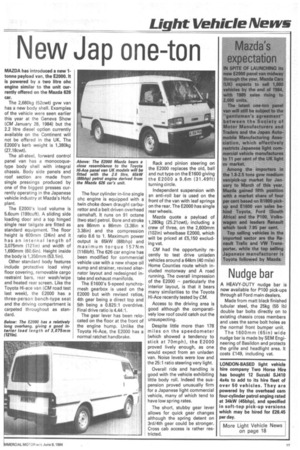New Jap one-ton
Page 19

If you've noticed an error in this article please click here to report it so we can fix it.
MAZDA has introduced a new 1tonne payload van, the E2000. It is powered by a two litre ohc engine similar to the unit currently offered on the Mazda 626
Car.
The 2,660kg (52cwt) gvw van has a new body shell. Examples of the vehicle were seen earlier this year at the Geneva Show (CM January 28, 1984) but the 2.2 litre diesel option currently available on the Continent will not be offered in the UK. The E2000's kerb weight is 1,380kg (27.18cwt).
The all-steel, forward control panel van has a monocoquetype body shell with integral chassis. Body side panels and roof section are made from single pressings produced by one of the biggest presses currently operating in the Japanese vehicle industry at Mazda's Hofu plant.
The E2000's load volume is 5.6cum (199cuft). A sliding side loading door and a top hinged single rear tailgate are fitted as standard equipment. The floor height is 609mm (24in) and it has an internal length of 3,075mm (121in) and width of 1,690mm (60.6in). Height inside the body is 1,350mm (53.1in).
Other standard body features include protective load vinyl floor covering, removable cargo restraint bars, rear wash/wipe and heated rear screen. Like the Toyota Hi-ace van (CM road test last week), the E2000 has a three-person bench-type seat and the driving compartment is carpeted throughout as standard.
The four cylinder in-line single ohc engine is equipped with a twin choke down draught carburettor and a belt driven overhead camshaft. It runs on 91 octane (two star) petrol. Bore and stroke are 86mm x 86mm (3.38in x 3.381n) and the compression ratio 8.6 to 1. Maximum power output is 65kW (88bhp) and maximum torque 1 5 7 Nm (116Ibft). The 626 car engine has been modified for commercial vehicle use with a new shape oil sump and strainer, revised alternator layout and redesigned intake and exhaust manifolds.
The E1600's 5-speed synchromesh gearbox is used on the E2000 but with revised ratios, 4th gear being a direct top and 5th being a 0.825:1 overdrive. Final drive ratio is 4.44:1.
The gear lever has been relocated on the floor at the front of the engine hump. Unlike the Toyota Hi-Ace, the E2000 has a normal ratchet handbrake. Rack and pinion steering on the E2000 replaces the old, ball and nut type on the E1600 giving the E2000 a 9.6m (31.4 9ft) turning circle.
Independent suspension with an anti-roll bar is used on the front of the van with leaf springs on the rear. The E2000 has single rear wheels.
Mazda quote a payload of 1,280kg (25.21cwt); including a crew of three, on the 2,600mm (102in) wheelbase E2000, which will be priced at £5,150 excluding vat.
CM had the opportunity recently to test drive unladen vehicles around a 64km (40 mile) Home Counties route which included motorway and A road running. The overall impression of the E2000 — particularly the interior layout, is that it bears many similarities to the Toyota Hi-Ace recently tested by CM.
Access to the driving area is good although the comparatively low roof could catch out the unsuspecting.
Despite little more than 178 miles on the speedometer (which showed a tendency to stick at 70mph), the E2000 proved lively enough, as one would expect from an unladen van. Noise levels were low and the 25:1 ratio steering very light.
Overall ride and handling is good with the vehicle exhibiting little body roll. Indeed the suspension proved unusually firm for a Japanese light commercial vehicle, many of which tend to have low spring rates.
The short, stubby gear lever allows for quick gear changes although the spring detent on 3rd/4th gear could be stronger. Cross cab access is rather restricted.
























































































